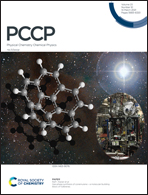Decrease in sulfate aerosol light backscattering by reactive uptake of isoprene epoxydiols†
Abstract
Sulfate aerosol is responsible for a net cooling of the Earth's atmosphere due to its ability to backscatter light. Through atmospheric multiphase chemistry, it reacts with isoprene epoxydiols leading to the formation of aerosol and organic compounds, including organosulfates and high-molecular weight compounds. In this study, we evaluate how sulfate aerosol light backscattering is modified in the presence of such organic compounds. Our laboratory experiments show that reactive uptake of isoprene epoxydiols on sulfate aerosol is responsible for a decrease in light backscattering compared to pure inorganic sulfate particles of up to – 12% at 355 nm wavelength and – 21% at 532 nm wavelength. Moreover, while such chemistry is known to yield a core–shell structure, the observed reduction in the backscattered light intensity is discussed with Mie core–shell light backscattering numerical simulations. We showed that the observed decrease can only be explained by considering effects from the complex optical refractive index. Since isoprene is the most abundant hydrocarbon emitted into the atmosphere, and isoprene epoxydiols are the most important isoprene secondary organic aerosol precursors, our laboratory findings can aid in quantifying the direct radiative forcing of sulfates in the presence of organic compounds, thus more clearly resolving the impact of such aerosol particles on the Earth's climate.



 Please wait while we load your content...
Please wait while we load your content...